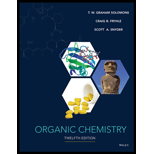
Concept explainers
Practice Problem 10.14
Show how the following compounds could be synthesized from phenylacetylene
(a) 1-phenylpropyne,
(b) 1-phenyl-1-butyne,
(c)(Z)-1-phenylpropene, and
(d)(E)-1-phenylpropene.
Begin each synthesis by writing a retrosynthetic analysis.
Want to see the full answer?
Check out a sample textbook solution
Chapter 10 Solutions
ORGANIC CHEM. VOL.1+2-W/WILEYPLUS
Additional Science Textbook Solutions
General Chemistry: Principles and Modern Applications (11th Edition)
General Chemistry: Atoms First
Elementary Principles of Chemical Processes, Binder Ready Version
Organic Chemistry
Chemistry: A Molecular Approach
Chemistry: The Molecular Nature of Matter
- 8. (a) Benzene derivatives exhibit medium to strong absorption in UV-region. Explain why aniline and phenoxide ion have strong UV-absorptions.arrow_forwardShow how the following ethers might be synthesized using (1) alkoxymercuration–demercuration and (2) the Williamson synthesis. (When one of these methods cannot beused for the given ether, point out why it will not work.)(a) 2-methoxybutanearrow_forward6. Provide mechanisms for the reactions below. Pay attention to the type of arrows that you use. You may use B: as a general base (a) HCI он H3C OH CH3 + H20 он (b) -Br H3CO -Br Br2 CH3OH DCH3 Explain why there are 2 products and how each can be favored. (c) use a OCH3 so3 OCH3 resonance H2SO, structure to indicate HO,S charge stabilizationarrow_forward
- The following series of reactions will yield 2) CI-CH2-CH2-C6H5 1) CH3CH2SH + N2OH O 2-chloro-4-ethyl-benzenesulfonic acid O CH;CH2-S-CH2CH2C6H5 O ortho-chloro-ethyl-benzene O 1-phenyl-3-chloro-propane O CH3CH2-O-CH2CH2C6H5arrow_forwardWrite arrow-pushing mechanisms for the following reaction. Make sure that your mechanisms explain the observed stereochemistry of the transformations, if relevant.arrow_forwardwe know that ethers, such as diethyl ether and tetrahydrofuran, are quite resistant to the action of dilute acids and require hot concentrated HI or HBr for cleavage. However, acetals in which two ether groups are linked to the same carbon undergo hydrolysis readily, even in dilute aqueous acid. How do you account for this marked difference in chemical reactivity toward dilute aqueous acid between ethers and acetals?arrow_forward
- Name each alkene and specify its configuration by the E,Z system. (Be sure to indicate double bond stereochemistry using (E)/(Z) notation. It is not necessary to use italics in writing compound names.) (a) (b) (c) Br A X Br 며arrow_forward9. Plan syntheses of the following compounds. You may use the given starting material and any compound containing three or fewer carbons. (a) (b) (c) (d) by Br or Br H Br H OH = OHarrow_forwardCompounds X and Y are both C7H15Cl products formed in the radical chlorination of 2,4-dimethylpentane. Base-promoted E2 elimination of X and Y gives, in each case, a single C7H₁4 alkene. Both X and Y undergo an SN2 reaction with sodium iodide in acetone solution to give C7H15l products; in this reaction Y reacts faster than X. What is the structure of X? • Do not use stereobonds in your answer. • In cases where there is more than one possible structure for each molecule, just give one for each. . Draw one structure per sketcher. Add additional sketchers using the drop-down menu in the bottom right corner. Separate structures with + signs from the drop-down menu. наarrow_forward
- A key step in the synthesis of naproxen, an NSAID more commonly known by its brand name, Aleve (Section 3.9), is a coupling reaction of 2-bromo6-methoxynaphthalene to form 2-methoxy-6-vinylnaphthalene. Show three different coupling reactions, and the required reagents, that could be used to carry out this step.arrow_forwardUsing your reaction roadmap as a guide, show how to convert 1-butanol and ethanol into racemic 2-ethoxy-1-butanol. You must use 1-butanol and ethanol as the source of all carbon atoms in the ether product. (1) (2) (3) OH (4) 2-ethoxy-1-butanol (racemic) OH OII.. Suggest reagents and experimental conditions for each step in this synthesis. From the choices provided, suggest appropriate reagents for each step. More than one reagent may be necessary. Use the minimum number of steps possible. Enter your answer as a letter, or a series of letters, in the order necessary to bring about the steps shown. Reagents: (c) ethylene oxide OH (a) (CH3)3 CO K+, THF (d) H₂SO4, H₂O (b) OsO4, H₂O2 Br OH + (9) H₂ SO4 (anhydrous) Na, NH3 (1) (k) NBS, heat (e) m-chloroperoxybenzoic acid (mCPBA) (f) pyridinium chlorochromatę) PBr3 (PCC) (h) NaOH (N-bromosuccinimide) Previous Nextarrow_forwardDevise a synthesis of each of the following compounds. Besides inorganic reagents, you may use hydrocarbons and halides having ≤ 6 C′s, and CH2=CHCOOCH3 as starting materials. Each synthesis must use at least one of the carbon–carbon bond-forming reactions.arrow_forward
 ChemistryChemistryISBN:9781305957404Author:Steven S. Zumdahl, Susan A. Zumdahl, Donald J. DeCostePublisher:Cengage Learning
ChemistryChemistryISBN:9781305957404Author:Steven S. Zumdahl, Susan A. Zumdahl, Donald J. DeCostePublisher:Cengage Learning ChemistryChemistryISBN:9781259911156Author:Raymond Chang Dr., Jason Overby ProfessorPublisher:McGraw-Hill Education
ChemistryChemistryISBN:9781259911156Author:Raymond Chang Dr., Jason Overby ProfessorPublisher:McGraw-Hill Education Principles of Instrumental AnalysisChemistryISBN:9781305577213Author:Douglas A. Skoog, F. James Holler, Stanley R. CrouchPublisher:Cengage Learning
Principles of Instrumental AnalysisChemistryISBN:9781305577213Author:Douglas A. Skoog, F. James Holler, Stanley R. CrouchPublisher:Cengage Learning Organic ChemistryChemistryISBN:9780078021558Author:Janice Gorzynski Smith Dr.Publisher:McGraw-Hill Education
Organic ChemistryChemistryISBN:9780078021558Author:Janice Gorzynski Smith Dr.Publisher:McGraw-Hill Education Chemistry: Principles and ReactionsChemistryISBN:9781305079373Author:William L. Masterton, Cecile N. HurleyPublisher:Cengage Learning
Chemistry: Principles and ReactionsChemistryISBN:9781305079373Author:William L. Masterton, Cecile N. HurleyPublisher:Cengage Learning Elementary Principles of Chemical Processes, Bind...ChemistryISBN:9781118431221Author:Richard M. Felder, Ronald W. Rousseau, Lisa G. BullardPublisher:WILEY
Elementary Principles of Chemical Processes, Bind...ChemistryISBN:9781118431221Author:Richard M. Felder, Ronald W. Rousseau, Lisa G. BullardPublisher:WILEY





